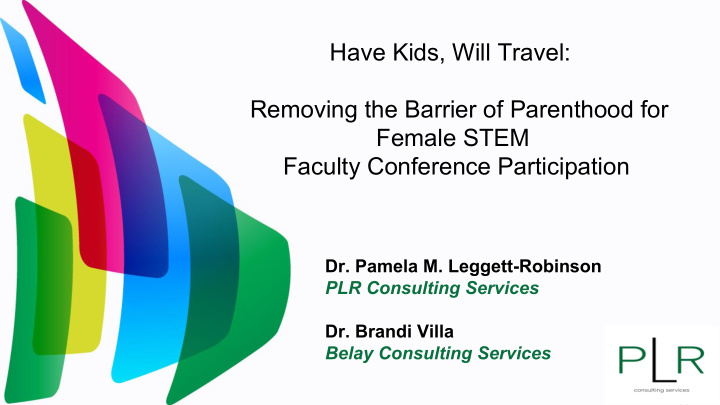



Have Kids, Will Travel: Removing the Barrier of Parenthood for Female STEM Faculty Conference Participation Dr. Pamela M. Leggett-Robinson PLR Consulting Services Dr. Brandi Villa Belay Consulting Services
Women in STEM Despite a plethora of initiatives and a surge of research activity within the last ten years, women remain underrepresented in science, technology, engineering, and mathematics (STEM) disciplines (National Science Foundation 2017). ● Most research and programs focus on ways to recruit women into these disciplines (undergraduate and graduate) ● Less work has explored the contexts once they have entered (as faculty) and why they leave
Gender Bias "the structure of university professorships reflects the male dominance of not only the university but society at large. Professorships were originally designed for men who had wives at home not only to care for home and children but also to provide support for the man's career" -- (Hensel, 1991). “the academic structural environment as it stands, has not worked sufficiently to fully integrate women (of color) academicians” --- (Lemelle, 2010). ● A major barrier for women in particular in STEM careers is the period of life in which they are starting their families. ● These barriers exclude a large proportion of early-career women and in so doing holds back science and discovery. ● For a decade or more, women are forced to choose between caring for their children or participating in professional activities that would advance their careers.
A Barrier for Female STEM Faculty: Professional Conferences ● Requirements for Tenure and/or Promotion: ○ Scholarly Activity (Research or Teaching), Teaching, and Service (regardless of institution) ○ For R1 institutions, scholarly activity ranks high ● Professional conferences are vital forums for academic researchers: communicate new discoveries, form research collaborations, make contacts with funding agencies, and attract new members to labs and programs ● Female STEM faculty struggle to attend key conferences and further their careers (Calisi, 2018): ○ No viable option for childcare while they travel ○ Limited financial resources to hire childcare for several days ○ Prefer to not leave their children overnight
Engagement/Reflection
Effects of the problem on STEM community ● Women are forced to choose between caring for their children or participating in professional activities that would advance their careers. ● A less-than-diverse professoriate in STEM fields undermines efforts towards increasing minority participation in STEM. ● Promotes the perception that colleges and universities (STEM departments) are unfriendly to the growth and maintenance of a family OR the ability to meet family demands while pursuing academic career) ● Perpetuates the historical definition of professorships (designed for men who had wives at home) ● Perpetuates gender bias --subtle, overt, or implicit. Implicit gender bias is systemic and is often found in the departments of higher education and higher education institutions.
Overcoming Barriers ● A national organization should exist with the sole purpose of enabling parents to attend and fully engage in conferences in their disciplines ● Breast pumping locations and access to refrigeration for breastmilk ● Utilization of STEM education activities for young children during session times ● More women on planning committees ● Free childcare - Mozilla Fest, Grace Hopper Celebration of Women in Coding
Long Term Benefits ● Increase in the number of female faculty participating in professional conferences; increase number of women obtaining tenure/promotion ● Exposure of STEM to young children ● Address implicit and explicit bias of “family” ● Allows not only mothers, but also fathers and other guardians, to relax and focus on the conference ● Addresses the “baby penalty” -- which negatively affects women’s, but not men’s, career mobility, with even larger penalties for women of color. ● Conference centers and host organizations can benefit directly from concerted efforts to plan more family-friendly events. They’re likely to have increased attendance, which yields increased revenue for organizations and conference centers, as well as for the hotels, restaurants, and retailers surrounding the meeting location ● Promoting a parent-friendly environment and culture, would send a strong message of support and inclusiveness
Recommend
More recommend